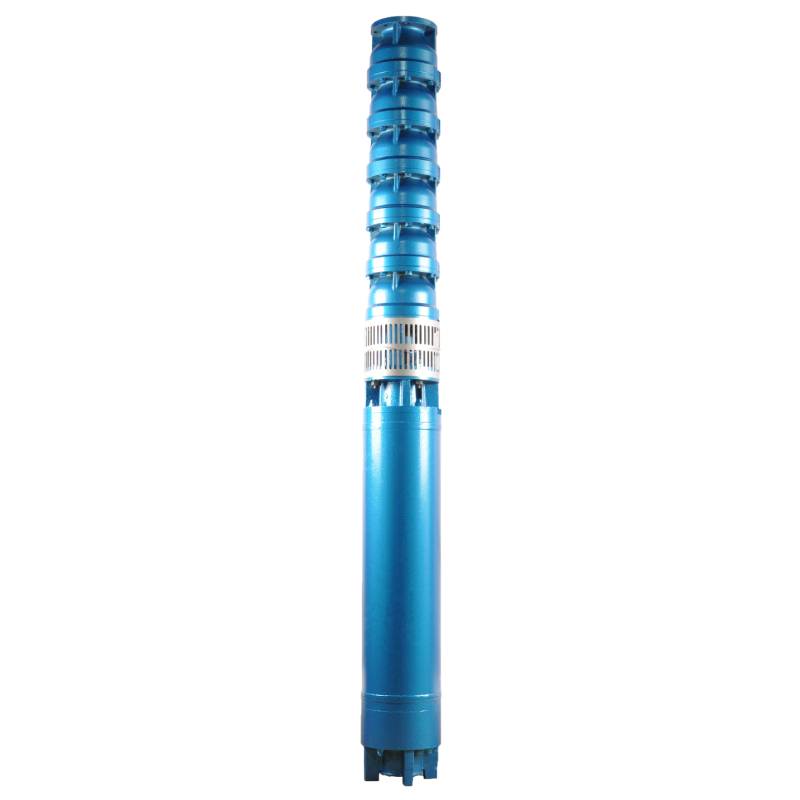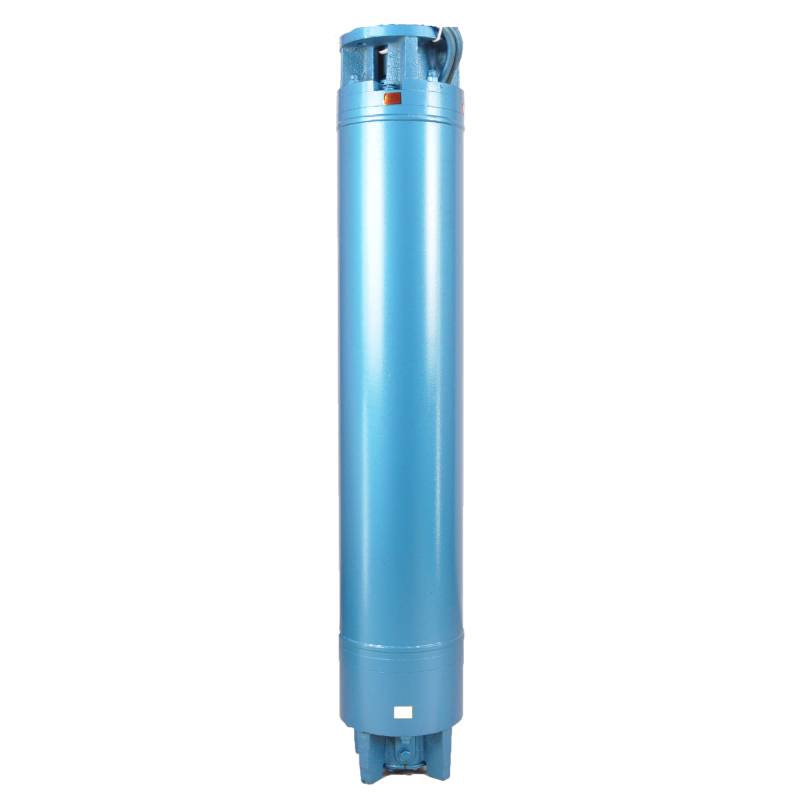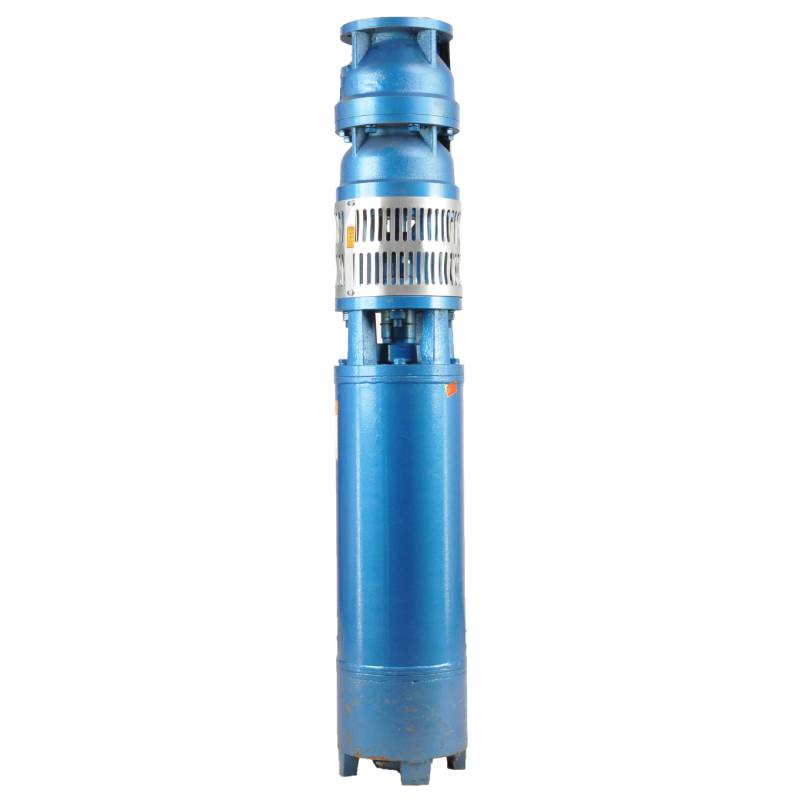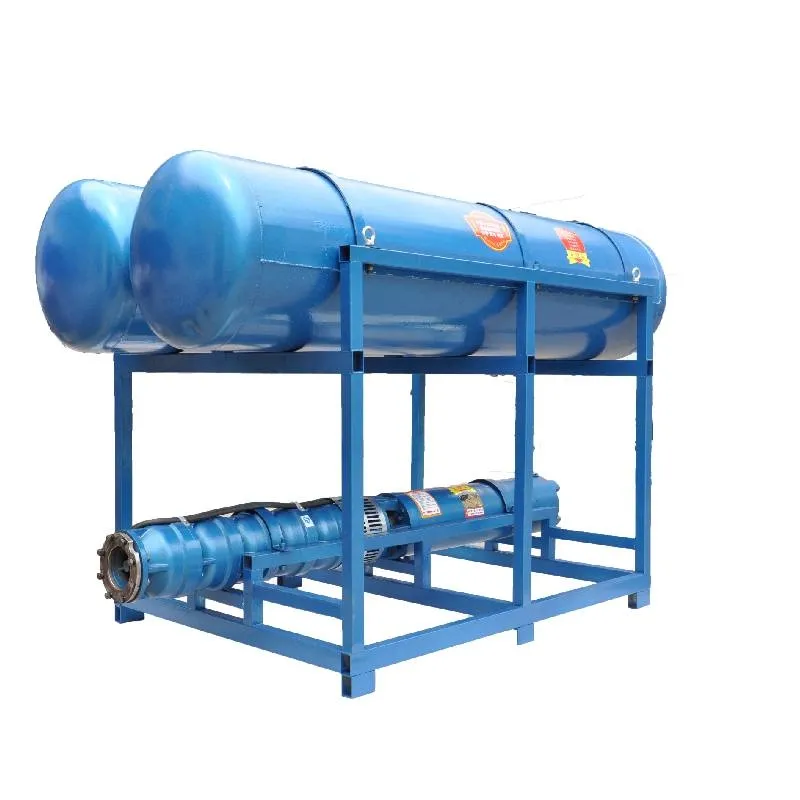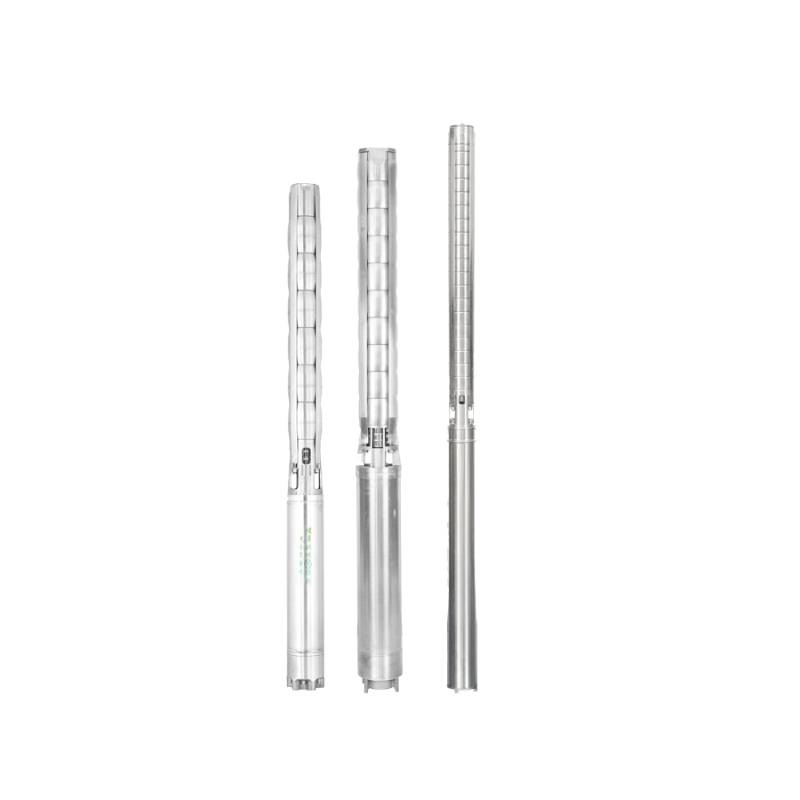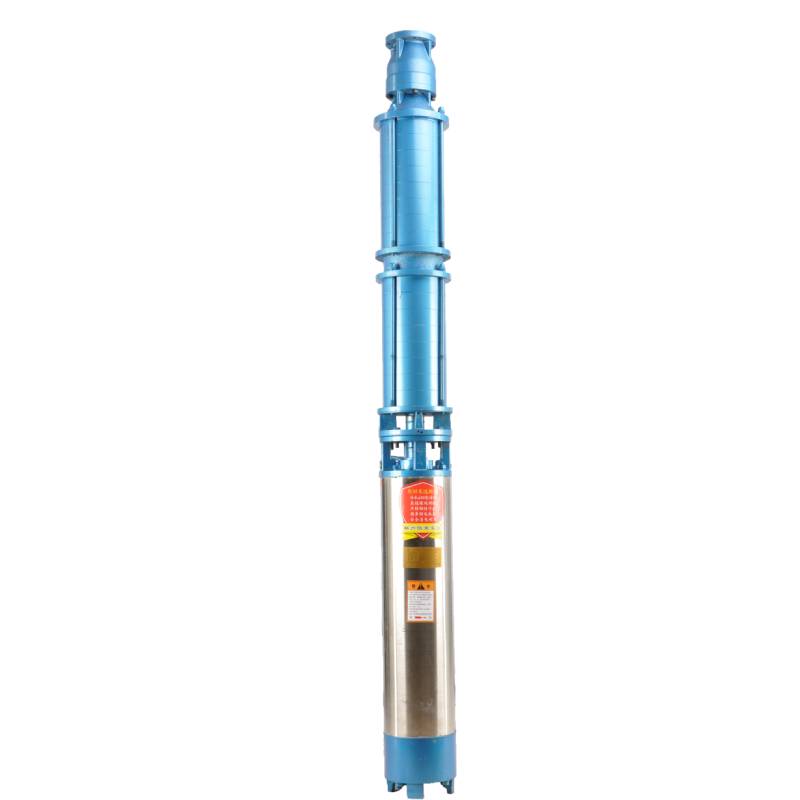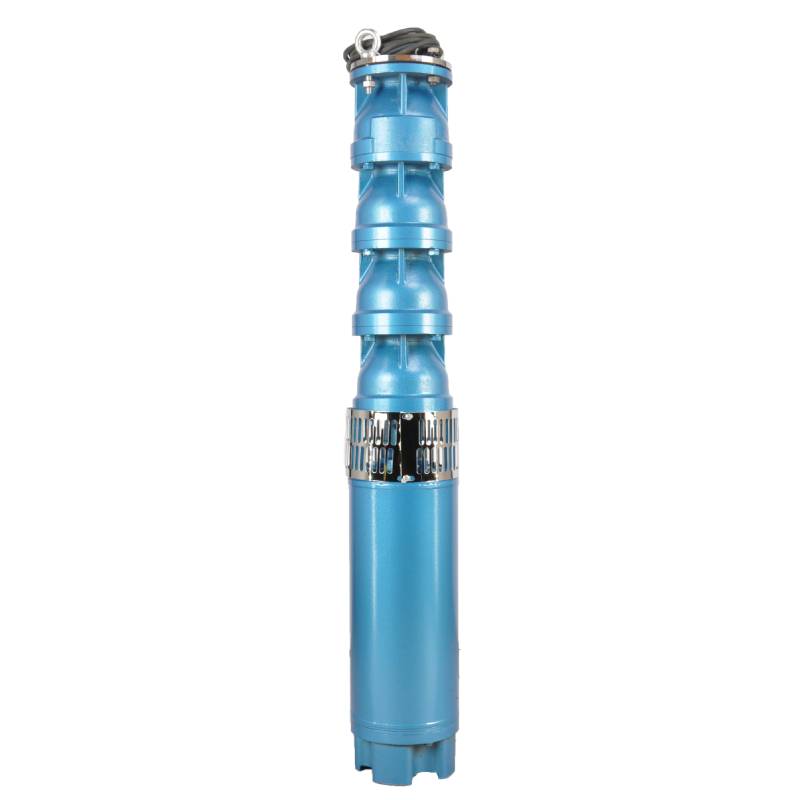The product adopts special waterproof wire design, which can realize long-term stable conversion operation of the motor within the frequency range of 1HZ-50HZ. The frequency conversion winding design not only makes the frequency conversion deep well pump more energy saving, but also prolongs its service life. The motor winding adopts special water-resistant conductors that are resistant to high frequency impact, pulse peak voltage impact and high temperature aging, with excellent characteristics and stability.
The product is powered by three-phase AC 380V power supply, 50HZ frequency, suitable for the environment with harsh water quality conditions. Specific requirements include water temperature below 20 °C, solid impurities content is not greater than 0.01%, PH value is 6.5-8.5, hydrogen sulfide content is not greater than 1.5mg/L, chloride ion content is not greater than 400mg/L. The product adopts closed or water immersion structure of the motor, before use to ensure that the pump is fully filled with water, no-load test run is strictly prohibited. The pump must be completely immersed in water, not more than 70m water depth, water source to meet the requirements of the pump water output and continuous operation. In addition, the well must be vertical, the pump can only be used vertically. The wiring should be supported according to the requirements, and equipped with external overload protection device. This series of requirements to ensure the efficient and stable operation of the product, suitable for all kinds of special environment of the pump demand.
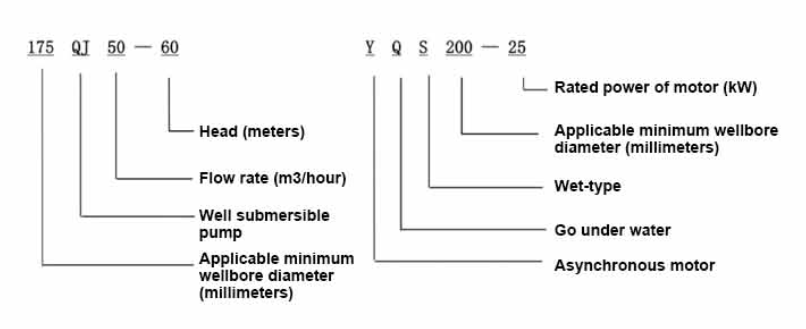
| Modail | Sruth (m3/h) | Ceann (m) |
Luas rothlach (atharrachadh/puing) |
Pumpa uisge (%) | Ar-a-mach trast-thomhas (mm) |
Gu math iomchaidh trast-thomhas (mm) |
Rangaichte power(KW) |
Rangaichte bholtaids (V) |
Rangaichte sruth (A) |
Èifeachdas motair (%) | power factorcosφ | Aonad Meud radial (mm) |
Facal | |||||||||
| 250QJ50-40 | 50 | 40 | 2875 | 72 | 80 | 250gu h-àrd | 9.2 | 380 | 21.7 | 78.5 | 0.82 | 233 | ||||||||||
| 250QJ50-60 | 60 | 13 | 30.1 | 80.0 | 0.82 | |||||||||||||||||
| 250QJ50-80 | 80 | 18.5 | 40.8 | 82.0 | 0.84 | |||||||||||||||||
| 250QJ50-100 | 100 | 22 | 47.9 | 83.0 | 0.84 | |||||||||||||||||
| 250QJ50-120 | 120 | 25 | 53.8 | 84.0 | 0.84 | |||||||||||||||||
| 250QJ50-140 | 140 | 30 | 64.2 | 84.5 | 0.84 | |||||||||||||||||
| 250QJ50-160 | 160 | 37 | 77.8 | 85.0 | 0.85 | |||||||||||||||||
| 250QJ50-200 | 200 | 45 | 94.1 | 85.5 | 0.85 | |||||||||||||||||
| 250QJ50-240 | 240 | 55 | 114.3 | 86.0 | 0.85 | |||||||||||||||||
| 250QJ50-280 | 280 | 63 | 131.0 | 86.0 | 0.85 | |||||||||||||||||
| 250QJ50-320 | 320 | 75 | 152.3 | 87.0 | 0.86 | |||||||||||||||||
| 250QJ50-400 | 400 | 90 | 182.8 | 87.0 | 0.86 | |||||||||||||||||
| 250QJ50-440 | 440 | 100 | 203.1 | 87.0 | 0.86 | |||||||||||||||||
| 250QJ63-40 | 63 | 40 | 2875 | 74 | 80 | 250gu h-àrd | 11 | 380 | 25.8 | 79.0 | 0.82 | 233 | ||||||||||
| 250QJ63-60 | 60 | 18.5 | 40.8 | 82.0 | 0.84 | |||||||||||||||||
| 250QJ63-80 | 80 | 22 | 47.9 | 83.0 | 0.84 | |||||||||||||||||
| 250QJ63-100 | 100 | 30 | 64.2 | 84.5 | 0.84 | |||||||||||||||||
| 250QJ63-120 | 120 | 37 | 77.8 | 85.0 | 0.85 | |||||||||||||||||
| 250QJ63-160 | 160 | 45 | 94.1 | 85.5 | 0.85 | |||||||||||||||||
| 250QJ63-200 | 200 | 55 | 114.3 | 86.0 | 0.85 | |||||||||||||||||
| 250QJ63-220 | 220 | 63 | 131.0 | 86.0 | 0.85 | |||||||||||||||||
| 250QJ63-260 | 260 | 75 | 152.3 | 87.0 | 0.86 | |||||||||||||||||
| 250QJ63-300 | 300 | 90 | 182.8 | 87.0 | 0.86 | |||||||||||||||||
| 250QJ63-360 | 360 | 100 | 203.1 | 87.0 | 0.86 | |||||||||||||||||
| 250QJ80-20 | 80 | 20 | 2875 | 75 | 100 | 250gu h-àrd | 7.5 | 380 | 18.0 | 78.0 | 0.81 | 233 | ||||||||||
| 250QJ80-40 | 40 | 15 | 33.9 | 81.0 | 0.83 | |||||||||||||||||
| 250QJ80-60 | 60 | 22 | 47.9 | 83.0 | 0.84 | |||||||||||||||||
| 250QJ80-80 | 80 | 30 | 64.2 | 84.5 | 0.84 | |||||||||||||||||
| 250QJ80-100 | 100 | 37 | 77.8 | 85.0 | 0.85 | |||||||||||||||||
| 250QJ80-120 | 120 | 45 | 94.1 | 85.5 | 0.85 | |||||||||||||||||
| 250QJ80-160 | 80 | 160 | 2875 | 75 | 100 | 250gu h-àrd | 55 | 380 | 114.3 | 86.0 | 0.85 | 233 | ||||||||||
| 250QJ80-180 | 180 | 63 | 131.0 | 86.0 | 0.85 | |||||||||||||||||
| 250QJ80-200 | 200 | 75 | 152.3 | 87.0 | 0.86 | |||||||||||||||||
| 250QJ80-240 | 240 | 90 | 182.8 | 87.0 | 0.86 | |||||||||||||||||
| 250QJ80-280 | 280 | 100 | 203.1 | 87.0 | 0.86 | |||||||||||||||||
| 250QJ100-18 | 100 | 18 | 2875 | 75 | 100 | 250gu h-àrd | 7.5 | 380 | 18.0 | 78.0 | 0.81 | 233 | ||||||||||
| 250QJ100-36 | 36 | 15 | 33.9 | 81.0 | 0.83 | |||||||||||||||||
| 250QJ100-54 | 54 | 25 | 53.8 | 84.0 | 0.84 | |||||||||||||||||
| 250QJ100-72 | 72 | 30 | 64.2 | 84.5 | 0.84 | |||||||||||||||||
| 250QJ100-90 | 90 | 37 | 77.8 | 85.0 | 0.85 | |||||||||||||||||
| 250QJ100-108 | 108 | 45 | 94.1 | 85.5 | 0.85 | |||||||||||||||||
| 250QJ100-126 | 126 | 55 | 114.3 | 86.0 | 0.85 | |||||||||||||||||
| 250QJ100-144 | 144 | 63 | 131.0 | 86.0 | 0.85 | |||||||||||||||||
| 250QJ100-162 | 162 | 75 | 152.3 | 87.0 | 0.86 | |||||||||||||||||
| 250QJ100-198 | 198 | 90 | 182.8 | 87.0 | 0.86 | |||||||||||||||||
| 250QJ100-216 | 216 | 100 | 203.1 | 87.0 | 0.86 | |||||||||||||||||
| 250QJ125-16 | 125 | 16 | 2875 | 76 | 125 | 250gu h-àrd | 9.2 | 380 | 21.7 | 78.5 | 0.82 | 233 | ||||||||||
| 250QJ125-32 | 32 | 18.5 | 40.8 | 82.0 | 0.84 | |||||||||||||||||
| 250QJ125-48 | 48 | 25 | 53.8 | 84.0 | 0.84 | |||||||||||||||||
| 250QJ125-64 | 64 | 37 | 77.8 | 85.0 | 0.85 | |||||||||||||||||
| 250QJ125-80 | 80 | 45 | 94.1 | 85.5 | 0.85 | |||||||||||||||||
| 250QJ125-96 | 96 | 55 | 114.3 | 86.0 | 0.85 | |||||||||||||||||
| 250QJ125-112 | 112 | 63 | 131.0 | 86.0 | 0.85 | |||||||||||||||||
| 250QJ125-128 | 128 | 75 | 152.3 | 87.0 | 0.86 | |||||||||||||||||
| 250QJ125-160 | 160 | 90 | 182.8 | 87.0 | 0.86 | |||||||||||||||||
| 250QJ125-176 | 176 | 100 | 203.1 | 87.0 | 0.86 | |||||||||||||||||
| 250QJ125-192 | 192 | 110 | 219.6 | 87.5 | 0.87 | |||||||||||||||||
| 250QJ140-15 | 140 | 15 | 2875 | 76 | 125 | 250gu h-àrd | 9.2 | 380 | 21.7 | 78.5 | 0.82 | 233 | ||||||||||
| 250QJ140-30 | 30 | 18.5 | 40.8 | 82.0 | 0.84 | |||||||||||||||||
| 250QJ140-45 | 45 | 30 | 64.2 | 84.5 | 0.84 | |||||||||||||||||
| 250QJ140-60 | 60 | 37 | 77.8 | 85.0 | 0.85 | |||||||||||||||||
| 250QJ140-75 | 45 | 45 | 94.1 | 85.5 | 0.85 | |||||||||||||||||
| 250QJ140-90 | 90 | 55 | 114.3 | 86.0 | 0.85 | |||||||||||||||||
| 250QJ140-105 | 140 | 105 | 2875 | 76 | 125 | 250gu h-àrd | 63 | 380 | 131.0 | 86.0 | 0.85 | 233 | ||||||||||
| 250QJ140-120 | 120 | 75 | 152.3 | 87.0 | 0.86 | |||||||||||||||||
| 250QJ140-150 | 150 | 90 | 182.8 | 87.0 | 0.86 | |||||||||||||||||
| 250QJ140-165 | 165 | 100 | 203.1 | 87.0 | 0.86 | |||||||||||||||||
| 250QJ140-180 | 180 | 110 | 219.6 | 87.5 | 0.87 | |||||||||||||||||
| 250QJ200-20 | 200 | 20 | 2875 | 75 | 150 | 250gu h-àrd | 18.5 | 380 | 40.8 | 82.0 | 0.84 | 233 | ||||||||||
| 250QJ200-40 | 40 | 37 | 77.8 | 85.0 | 0.85 | |||||||||||||||||
| 250QJ200-60 | 60 | 55 | 114.3 | 86.0 | 0.85 | |||||||||||||||||
| 250QJ200-80 | 80 | 75 | 152.3 | 87.0 | 0.86 | |||||||||||||||||
| 250QJ200-100 | 100 | 90 | 182.8 | 87.0 | 0.86 | |||||||||||||||||
| 250QJ200-120 | 120 | 100 | 203.1 | 87.0 | 0.86 | |||||||||||||||||
| 250QJ200-140 | 140 | 125 | 249.5 | 87.5 | 0.87 | |||||||||||||||||
1, well submersible pump for clean water pump, prohibit the new well, pumping sediment and muddy water,
2, well water pump voltage grade of 380/50HZ, the use of other voltage grades of submersible motors need to be customized. The underground cable must use waterproof cable, must be equipped with starting equipment, such as distribution box, start not ready should have commonly used motor comprehensive protection function, such as short circuit overload protection, phase protection, undervoltage protection, grounding protection, idling protection, in case of abnormal conditions, the protection device should be timely action trip.
3, the installation and use of the pump must be reliably grounded, prohibit the push and pull switch when the hands and feet are wet, the installation and maintenance of the pump must be cut off the power supply, the use of the pump place to set up "to prevent electric shock" obvious signs:
4, down the well or before installation, the motor cavity must be filled with distilled water or non-corrosive clean cold boiling water, tighten the / water bolt, the pump on the ground test run, must be to the pump chamber water lubrication rubber bearings, instant start not more than a second, see whether the steering is the same as the steering instructions. When the pump is upright, pay attention to safety, prevent overturning injury.
5, gu teann a rèir ullachaidhean an lioft pumpaidh, raon cleachdaidh sruthadh, gus casg a chuir air sruthadh ìosal no feachd pumpaidh àrdachaidh, giùlan smeòrach agus pàirtean eile den chaitheamh, loisg an cus motair
6, after the pump down the well, the measurement of the motor to the ground insulation resistance should not be less than 100M, after the start to observe the voltage and current, check the motor winding insulation, whether in line with the requirements; pump storage location temperature if less than freezing point, should be dry the motor cavity water, prevent the motor cavity water ice damage caused by low temperature.
The pump parts are mainly composed of pump shaft, impeller, shunt shell, rubber bearing, check valve body and so on; the motor part mainly includes base, pressure regulating diaphragm, thrust bearing, thrust plate, lower guide bearing seat, stator, rotor, upper guide bearing seat, sand discharging ring, water inlet section, cable lead, etc. The main characteristic of the product is that the motor is a water-filled wet submersible three-phase asynchronous motor, the motor cavity is filled with water, used to cool the motor and lubricate the bearing; the pressure regulating diaphragm at the bottom is used to adjust the expansion and contraction pressure difference of the internal water caused by the change of the temperature rise of the motor. In order to prevent the sand particles in the well water from entering the motor, two sand sealing rings are installed on the upper end of the motor shaft extension, and a sand discharging ring is installed to form a sand prevention structure. To prevent the pump shaft from jumping when starting up, the pump shaft is connected with the motor shaft through a coupling, and the thrust bearing is installed on the lower part of the motor. The motor and pump bearing adopt water lubrication technology, and the stator winding of the motor adopts high quality submersible motor winding with high insulation performance. The pump is designed by computer CAD, with simple structure and excellent technical performance.

(1) Ag ullachadh mus stàladh:
1. Dèan cinnteach a bheil am pumpa fon uisge a’ coinneachadh ris na cumhaichean cleachdaidh agus an raon a tha air a shònrachadh san leabhar-làimhe.
2. A’ cleachdadh inneal trom le trast-thomhas co-ionann ris an trast-thomhas a-muigh as àirde den phump a tha fon uisge, tomhais an urrainn dha trast-thomhas a-staigh an tobair a bhith a’ freagairt air a’ phumpa fon uisge, agus tomhas a bheil doimhneachd an tobair a’ coinneachadh ri riatanasan an stàlaidh.
3. Dèan cinnteach a bheil toll an tobair glan agus a bheil uisge an tobair turbid. Na cleachd pumpa dealain fon uisge gu bràth gus poll pumpa welor agus uisge gainmhich a nighe gus milleadh ro-luath air a’ phump dealain fon uisge a sheachnadh.
4. Dèan cinnteach a bheil suidheachadh a’ chlamp stàlaidh welhead freagarrach agus an urrainn dha seasamh ri càileachd an aonaid gu lèir
5. Dèan cinnteach a bheil na pàirtean pumpa fon uisge coileanta agus air an stàladh ceart a rèir an diagram cruinneachaidh san leabhar-làimhe Thoir air falbh an scrion sìoltachain agus cuairteachadh a’ chàraid gus faicinn a bheil e a ’tionndadh gu sùbailte
6. Unscrew an sgriubha uisge agus lìon a’ chuas motair le uisge glan, neo-chreimneach (nota. bi cinnteach gun cuir thu a-steach e), agus an uairsin teannachadh an sgriubha uisge. Às deidh 12 uair de in-stealladh uisge, cha bu chòir an aghaidh insulation an motair a bhith nas ìsle na 150M Q nuair a thèid a thomhas le clàr crathadh 500V.
7. Cable joint, cut off a 120mm rubber sleeve from one end of the outgoing cable and the matching cable with an electrician's knifethen stagger the length of the three core wires in a stepped shape, peel off a 20mm copper core, scrape of the oxide layer on theoutside of the copper wire with a knife or sand cloth, and insert the two connected wire ends in palirs.After tying the layer tightly with fine copper wire, solder it thoroughly and firmly, and sand of any. burrs on the surface. Then, forthe three joints, use polyvester insulation tape to wrap them in a semi stacked manner for three lavers. Wrap the two ends of thewrapping layer tightywith nyion thread,and then use a semi stacked method to wrap the tape for three layers. Wrap the outellayer with high-pressure insulation tape for three layers. Finally, fold the threestrands together and repeatedly wrap them for fivelayers with high-pressure tape. Each layer must be tightly tied, and the interlayer joints must be tight and fimm to prevent water frompenetrating and damaging the insulation, After wrapping, soak in water at room temperature of 20 ’c for 12 hours, and measurethe insulation resistance with a shaking table, which should not be less than 100M Ω
Tha an diagram pròiseas sreangadh càball ceangailte mar a leanas: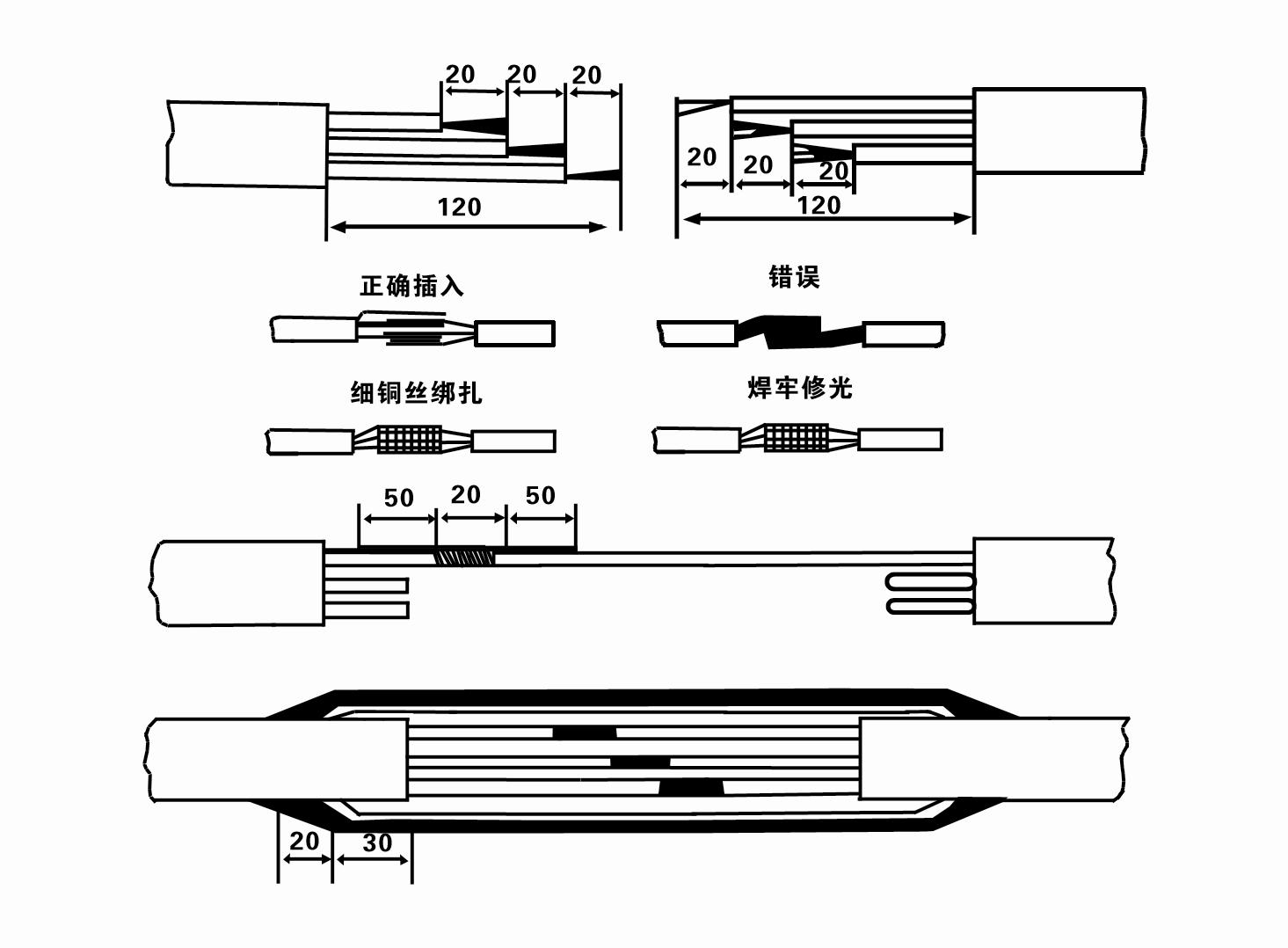
8. Cleachd multimeter gus dèanamh cinnteach a bheil na h-uèirichean trì-ìrean ceangailte agus a bheil an aghaidh DC timcheall air cothromach.
9. Dèan cinnteach a bheil cus luchd air a’ chuairt agus comas an cruth-atharrachaidh, agus an uairsin ceangail an tionndadh dìon cus cuideim no an uidheamachd tòiseachaidh. Faic Clàr 2 airson modalan sònraichte, agus an uairsin dòirt bucaid uisge a-steach don phump uisge bhon ionad pumpa uisge gus na giùlan rubair a lubricadh anns a’ phump, agus an uairsin cuir am pumpa dealain fon uisge gu dìreach agus gu seasmhach.Start (gun a bhith nas fhaide na aon diog). agus dèan cinnteach a bheil an stiùireadh stiùiridh co-chòrdail ris an t-soidhne stiùiridh. Mura h-eil, suaip dà cheangail den chàball trì-ìre.Then stàlaich an criathrag agus ullaich airson a dhol sìos an tobar. Ma thèid a chleachdadh aig amannan sònraichte (leithid dìgean, dìgean, aibhnichean, lochan, lòin, msaa), feumaidh am pumpa dealain a bhith air a chuir air bhonn gu h-earbsach.
(2) Uidheam agus innealan stàlaidh:
1. Aon phaidhir de shlabhraidhean togail airson barrachd air dà thunna.
2. Tripod le àirde dìreach nach eil nas lugha na ceithir meatairean.
3. Dà ròp crochte (ròpaichean uèir) as urrainn cuideam nas motha na aon tunna a ghiùlan (faodaidh cuideam seata iomlan de phumpaichean uisge a ghiùlan).
4. Stàlaich dà phaidhir de clamps (splints).
5. Wrenches, ùird, screwdrivers, innealan dealain agus ionnstramaidean, msaa.
(3) Stàladh pumpa dealain:
1. Tha an diagram stàlaidh den phump dealain submersible air a shealltainn ann am Figear 2. Tha na tomhasan stàlaidh sònraichte air an sealltainn ann an Clàr 3 "Liosta de mheudan stàlaidh a' phump dealain fon uisge".
2. Faodar pumpaichean dealain fon uisge le ceann nas lugha na 30 meatair a thogail gu dìreach a-steach don tobar le bhith a’ cleachdadh phìoban agus ròpaichean uèir no ròpannan hemp eile as urrainn làn chuideam an inneil gu lèir, pìoban uisge, agus uisge anns na pìoban a ghiùlan.
3. Bidh pumpaichean le ceann nas motha na 30 meatair a 'cleachdadh pìoban stàilinn, agus tha an sreath stàlaidh mar a leanas:
① Cleachd clamp gus ceann shuas pàirt a’ phump uisge a chlampadh (tha am pumpa motair is uisge air a cheangal aig an àm seo), tog e le slabhraidh crochte, agus ceangail gu slaodach a-steach don tobar gus an cuir thu an clamp air ceann an tobair agus thoir air falbh an slabhraidh crochte.
② Cleachd paidhir clamps eile gus pìob a chlampadh, tog e le slabhraidh crochte 15 cm air falbh bhon flange, agus lughdaich e gu slaodach. Eadar flange pìoba agus flange pumpa Cuir am pasgan rubair na àite agus teannachadh a’ phìob agus am pumpa gu cothromach le boltaichean, cnothan agus nigheadairean earraich.
③ Tog beagan am pumpa fon uisge, thoir air falbh an clamp air ceann shuas a’ phump uisge, ceangail an càball gu daingeann ris a’ phìob uisge le teip plastaig, agus ceangail sìos e gu slaodach gus an tèid an clamp a chuir aig ceann an tobair.
④ Cleachd an aon dòigh airson a h-uile pìob uisge a cheangal a-steach don tobar.
⑤ Às deidh don chàball luaidhe a bhith ceangailte ris an suidse smachd, tha e ceangailte ris an t-solar cumhachd trì ìrean.
(4) Rudan ri thoirt fa-near aig àm an stàlaidh:
1. Ma lorgar iongantas jamming tron phròiseas pumpaidh, tionndaidh no tarraing am pìob uisge gus faighinn thairis air a’ phuing jamming. Mura h-eil grunn cheumannan ag obair fhathast, feuch nach toir thu air a’ phump sìos gus milleadh a sheachnadh air a’ phump dealain fon uisge agus an tobar.
2. Rè an stàladh, bu chòir ceap rubair a chuir aig flange gach pìoba agus a theannachadh gu cothromach.
3. Nuair a thèid am pumpa uisge a leigeil a-steach don tobar, bu chòir a chuir ann am meadhan pìob an tobair gus casg a chuir air a ’phump bho bhith a’ ruith an-aghaidh balla an tobair airson ùine mhòr, ag adhbhrachadh gum bi am pumpa a ’crith agus an motair a’ sguabadh agus a losgadh .
4. Obraich a-mach doimhneachd a' phump uisge gu bonn an tobair a rèir suidheachadh gainmhich is eabar an tobair. Na cuir a-steach am pumpa san eabar. Mar as trice chan eil an astar bhon phump uisge gu bonn an tobair nas lugha na 3 meatairean (faic Figear 2).
5. Cha bu chòir doimhneachd inntrigidh uisge a’ phump uisge a bhith nas lugha na 1-1.5 meatairean bhon ìre uisge fiùghantach chun nód uisge a-steach (faic Figear 2). Rud eile, dh ’fhaodadh na giùlan pumpa uisge a bhith air am milleadh gu furasta.
6. Chan urrainn togail a' phump uisge a bhith ro ìosal. Rud eile, feumar bhalbhaichean geata a chuir a-steach air loidhne-phìoban uisge ceann an tobair gus smachd a chumail air sruthadh a’ phump aig a’ phuing sruthadh ìre gus casg a chuir air a’ motair a bhith air a luchdachadh cus agus a losgadh a-mach air sgàth ìrean sruth mòr.
7. Nuair a bhios am pumpa uisge a 'ruith, bu chòir an toradh uisge a bhith leantainneach agus eadhon, bu chòir an sruth a bhith seasmhach (fo chumhachan obrach comharraichte, mar as trice gun a bhith nas fhaide na 10% den t-sruth), agus cha bu chòir crith no fuaim a bhith ann. Ma tha ana-cainnt sam bith ann, bu chòir stad a chuir air an inneal gus faighinn a-mach an adhbhar agus cuir às dha.
8. Nuair a bhios tu a’ stàladh, thoir aire do shuidheachadh an uèir talmhainn motair (faic Figear 2). Nuair a tha am pìob uisge na phìob stàilinn, stiùir e bhon chlamp ceann tobair; nuair a tha am pìob uisge na phìob plastaig, stiùir e bho chomharra bunaiteach a’ phump dealain.
- 1.After the submersible pump is installed, check the insulation resistance and three-phase conduction from the switch again, check whether the instrument and the connection of the start 2.equipment are wrong, if there is no problem, the trial machine can be started, and observe whether the indicator readings of the instrument exceed the rated voltage and current specified on 3.the nameplate after the start, and observe whether the pump has noise and vibration phenomenon, and put into operation if everything is normal.
- 4.After the first operation of the pump for four hours, the motor should be shut down to test the thermal insulation resistance quickly, and its value should not be less than 0.5 megaohm.
- 5.After the pump is shut down, it should be started after five minutes to prevent the water column in the pipe from being completely reflowed and causing excessive motor current and burnout.
- 6.After the pump is put into normal operation, in order to prolong its service life, it is necessary to check whether the supply voltage, working current and insulation resistance are normal regularly. If the following conditions are found, the pump should be shut down immediately to troubleshoot.
- 1 In the rated condition, the current exceeds 20%.
- 2 Bidh an ìre uisge fiùghantach a’ tuiteam chun roinn uisge a-steach, ag adhbhrachadh uisge eadar-amail.
- 3 Tha fìor chrith no fuaim aig a’ phump a tha fon uisge.
- 4 Tha an bholtadh solair nas ìsle na 340 volts.
- 5 Tha fiùs air a losgadh a mach.
- 6 Tha am pìob solarachaidh uisge air a mhilleadh.
- 7 The motor's thermal insulation resistance is lower than 0.5 megaohm.
- Unit disassembly:
- 1 Untie the cable tie, remove the pipeline part, and remove the wire plate. 2 screw down the water bolt, put the water in the motor chamber.
- 3 thoir air falbh an criathrag, leig às an sgriubha stèidhichte air a’ chàraid gus an inneal motair a chàradh.
- 4 sgriubha sìos am bolt a ’ceangal an roinn uisge a-steach leis a’ motair, agus dealaich am pumpa bhon motair (thoir aire do chuisean an aonaid nuair a bhios tu a ’sgaradh, gus casg a chuir air lùbadh a’ chrann pumpaidh)
- 5 is e an t-sreath disassembly a’ phump: (faic figear 1) earrann in-ghabhail uisge, impeller, slige tar-chuir, impeller ...... thoir sùil air a’ bhodhaig bhalbhaichean, nuair a bheir thu air falbh an impeller, cleachd innealan sònraichte gus sleagh bideanach an inneal stèidhichte a leigeil ma sgaoil. impeller an toiseach, agus seachain lùbadh agus bruiseadh a’ chrann pumpa nuair a thèid a chuir às a chèile.
- 6 is e pròiseas disassembly an motair: (faic figear 1) cuir an motair air an àrd-ùrlar, agus thoir air falbh na cnothan, bonn, cnò glasaidh ceann shailean, plàta smeòrach, iuchair, cathair giùlain iùil nas ìsle agus bolt ceann dùbailte bho bhonn na an motair an uair sin, agus an uairsin thoir a-mach an rotor (thoir an aire gun a bhith a’ dèanamh cron air a ’phacaid uèir) agus mu dheireadh thoir air falbh an earrann ceangail agus an t-suidheachan stiùiridh àrd.
- 7 aonad co-chruinneachadh: ron cho-chruinneachadh, bu chòir meirge is salachar nam pàirtean a ghlanadh, agus an uachdar suirghe agus na fasteners air an còmhdach le sealant, agus an uairsin air an cruinneachadh san òrdugh disassembly mu choinneamh (bidh an inneal motair a’ gluasad suas is sìos às deidh co-chruinneachadh airson timcheall air aon). millimeter), às deidh co-chruinneachadh, bu chòir gum biodh an ceangal sùbailte, agus an uairsin an inneal deuchainn sgrion sìoltachain. Thèid pumpaichean fon uisge a thoirt a-mach às an tobar airson an toirt às agus an cumail suas a rèir Artaigil 5 às deidh bliadhna obrachaidh, no nas lugha na bliadhna obrach ach dà bhliadhna de ùine dàibhidh, agus thèid na pàirtean caithte a chuir nan àite.
In order to ensure the long-term use and stable performance of submersible electric pump, we have launched a convenient and practical product. The product has a unique design, easy operation, and is perfect for various application scenarios. After use, remember to discharge all the water in the electric pump, especially in winter, so as not to freeze the motor. Wind the cable and bundle it. Store it in an environment without corrosive substances and gases, and keep the temperature below 40 °C. In addition, if you do not use it for a long time, you should pay attention to prevent the submersible electric pump from rusting. Choose our products to make your work more convenient and efficient.
- Impeller
- Muinchille shaft
- Muinchill rubair
-
Cearcall ròin
01 Tobar uisge domhainn
02 Solar uisge àrd
03 solar uisge beinne
04 tùr uisge
05 Uisgeachadh àiteachais
06 uisgeachadh gàrraidh
07 toirt a-steach uisge aibhne
08 uisge dachaigheil

